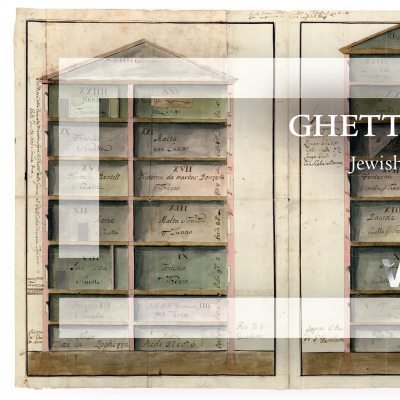
The Ghett/App mobile application was developed by Paolo Borin, Ludovica Galeazzo and Victoria Szabo of the Visualizing Venice team. The project was designed to complement the physical exhibition “Venice, the Jews and Europe 1516-2016,” which was held at the Palazzo Ducale in Venice from June 19 – November 13, 2016. The app itself will continue to live on in various forms after the close of the exhibition as a place to share relevant research in context.
Ghett/App is a augmented reality multimedia app designed to be used on-site in the Venetian Ghetto. It highlights fourteen geolocated points of interest, drawing attention to the built features of the space as they have changed over time, through text, audio, image, video, and augmented reality experiences. While some of the app content was adapted from the museum exhibition as a way to situate the user, the augmented reality features were designed especially for use on location, and to take advantage of being in the actual space under discussion.
The team layered schematic 3D models of historic buildings with contemporary panorama images in order to demonstrate architectural change over time within the once-enclosed area of the Ghetto. Users can use the phone’s motion features to explore the panorama scenes dynamically. The ghostly edifices of the past rise up through the phone display, highlighting the changing nature of experience in the space. The AR features complement text and audio commentaries in English and Italian that explain the significance of particular structures, as well as the overall history of the area. While this version of the project was rolled out in conjunction with the exhibition opening, the team plans to continue developing content out of historical research materials, and integrating it into app channels. They hope to include some new materials developed by students in the Visualizing Venice Summer Workshop, as well as to explore other innovative ways to present content through image recognition and other advanced AR techniques. Szabo plans to include AR storytelling about Venice as a unit in her Digital Storytelling class at Venice International University this Fall as well.
People Involved With The Project
- Victoria Szabo, Associate Research Professor, Art, Art History & Visual Studies (Co-Primary Investigator)
- Ludovica Galeazzo, IUAV University in Venice, Italy and Postdoctoral Associate, Art, Art History & Visual Studies (Co-Primary Investigator)
- Paolo Borin, PhD Candidate, Università degli Studi di Padova (Co-Primary Investigator)